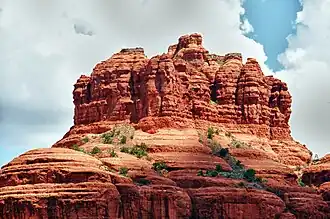Schnebly Hill Formation
| Schnebly Hill Formation | |
|---|---|
| Stratigraphic range: [1] | |
 | |
| Thickness | 800 feet (240 m) to 1,000 feet (300 m) |
| Lithology | |
| Primary | Sandstone |
| Location | |
| Region | Colorado Plateau |
| Country | United States |
| Type section | |
| Named for | Sedona Schnebly |
| Location | Arizona |
| Thickness at type section | 800 feet (240 m) to 1,000 feet (300 m) |
The Schnebly Hill Formation is a section of red bed deposits found at the Colorado Plateau, near Sedona, Arizona. It is a dark red sandstone, from 800 feet (240 m) to 1,000 feet (300 m) thick. It lies between Coconino Sandstone and the older Hermit Formation.[2] It is near the Supai Group.[3]
The source of the name "Schnebly" is Sedona Schnebly, after whom the city of Sedona, Arizona, was named.[4]
Geology
The formation traces to the Permian Age.[5][6]
The formation is the most prominent layer of the red rocks of the Sedona area due the presence of hematite – iron-oxide (rust) – giving the sandstone a red color. The Schnebly Hill Sandstone formation comprises three sections:
- the Bell Rock member,
- the Fort Apache member, and
- the Sycamore Pass member.[7]
See also
Sedona-area rocks
- Bell Rock
- Capitol Butte
- Cathedral Rock
- Courthouse Butte
- Red Rock State Park
- Slide Rock State Park
- Two Nuns
Local geology
Local interest
- Cottonwood, Arizona
- Honanki
- Jerome, Arizona
- Jerome State Historic Park
- Chapel of the Holy Cross
- Oak Creek Canyon
- Palatki Heritage Site
- Slide Rock State Park
References
- ^ "Geologic Unit: Haskell". National Geologic Database. Geolex — Significant Publications. United States Geological Survey. Retrieved 2023-12-15.
early Permian (Leonardian)
- ^ Cook, Terri (November 20, 2015). "Travels in Geology: Sedona: A journey to the edge of a supercontinent".
- ^ Blakey, Ronald C. "Central Arizona" (PDF). Archived from the original (PDF) on March 5, 2021.
- ^ "History of Sedona".
- ^ Waverly, Lowell (January 9, 2017). "Chapel in the Rocks". Retrieved 2022-03-07.
- ^ Bills, Donald J. "USGS Scientific Investigations Report 2005-5222, plate 1" (PDF).
- ^ Voges, Brianna. "Sedona Red Rock Formation".